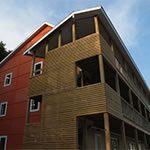Fire
In October 2011, a timber-framed apartment building originally constructed in the 1800s in Thomaston, Maine, was severely damaged in a fire. In the aftermath, Black Bros. Builders was hired to ensure that the new apartment complex erected on site would be a positive asset for its owners and the planet.
Black Bros. exclusively builds net-zero-energy structures, and from the aftermath of the fire, the builders raised the Sail Loft Zero Energy Apartments. Before the fire, the building held twelve apartments across two floors. Now, the three-story, nine-unit building offers a mixture of one- and two-bedroom apartments.
Because of the fire, the team was unable to reuse much of the existing building for the new living spaces—the unburned timbers were donated to a local nonprofit railroad preservation group—and the existing foundation was also in poor shape from 200 years of use. Black Bros. took the structure down to its foundation and installed a super-insulated slab in its place.
Costs
The project demanded a quick, six-month timeline. Black Bros. Builders teamed up with Kaplan Thompson Architects, a regular collaborator, which responded with an efficient 60-foot by 36-foot layout that employed identical unit layouts to help minimize costs and save time. “Simplicity in design and construction made this project possible,” says Brenan Black, one of the cofounders of Black Bros.
To convince the owner to pursue net-zero energy, despite increased upfront costs, Black and his brother compared the quotes the owner received. A merely code-compliant project would cost almost as much as the proposed net-zero building. The equilibrium point in expenses was only about a year, making the Black Bros. building the significantly cheaper option in the long run. “It was a classic no-brainer for him to decide to go with net zero,” says Black, who typically completes net-zero projects within ten percent of standard construction costs, resulting in an average payback period of three years for, say, a single-family home.

Black Bros. executed the repairs and upgrades within just a six-month timeframe.
Scale
The Sail Loft project is one of just six net-zero multifamily buildings in the country and the first in Maine. Although being on the cutting edge often poses additional challenges, Black Bros. found advantages to scaling up. Because shared walls, ceilings, and floors keep conditioned air inside a building, the team merely had to employ its proven multifamily methodology on a larger scale to achieve the energy savings it desired.
In fact, the firm air-sealed the entire envelope as a whole, instead of unit-by-unit, so that each apartment contributes to the overall conditioning load. The structure contains double exterior walls that are super-insulated to an R-value of 45. Roofs hit R-70. Efficient electric heating and hot-water production are paired with rooftop photovoltaics. “All these things we had done before—in fact, we haven’t changed our methodology much before or since,” Black says, adding that he believes the company’s approach could work consistently at any scale.
“This project is a drop in the bucket of things to come,” Black says. Recently, the company has begun selling and installing net-zero-energy homes by BrightBuilt Home. The modular homes are more affordable than comparable stick-built residences, increasing the reach of net zero to encompass owners on more modest budgets. “Why every builder in the US has not embraced this methodology is beyond us,” Black says. “It is truly a feel-good business model and profitable to boot.”

